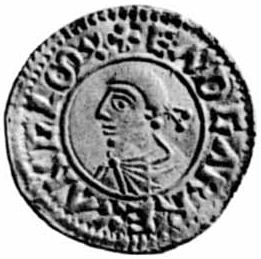 | ||
The English Penny, originally a coin of 1.3 to 1.5 grams (0.042 to 0.048 troy ounces; 0.046 to 0.053 ounces) pure silver, was introduced around the year 785 by King Offa of Mercia. These coins were similar in size and weight to the continental deniers of the period, and to the Anglo-Saxon sceats which had gone before it.
Contents
Throughout the period of the Kingdom of England, from its beginnings in the 9th century, the penny was produced in silver. Pennies of the same nominal value, one 240th of a pound sterling, were in circulation continuously until the creation of the Kingdom of Great Britain in 1707.
History
The name "penny" comes from the Old English pennige (pronounced [ˈpɛnijə], roughly "penny-yə"), sharing the same root as the German pfennig. Its abbreviation d. comes from the Roman denarius and was used until decimalisation in 1971.
Anglo-Saxon silver pennies were the currency used to pay the Danegeld, essentially protection money paid to the Vikings so that they would go away and not ravage the land. As an illustration of how heavy a burden the Danegeld was, more Anglo-Saxon pennies from the decades around the first millennium have been found in Denmark than in England. In the reign of Ethelred the Unready (978–1016), some 40 million pennies were paid to the Danes, while King Canute (Knut) (1016–1035) paid off his invasion army with another 20 million pennies. This adds up to about 2,800,000 troy ounces (87 tonnes; 96 short tons) of silver, equivalent to £250,000 at the time, and worth about £10 million in 2005 money (its purchasing power at that time may have exceeded £100 million and may have been as high as £1 billion in 2005).
The penny initially weighed 20 to 22.5 modern grains (1.3 to 1.5 g). It was standardized to 32 Tower grains, 1/240th of a Tower pound (approx. 350 g). The alloy was set to sterling silver of 925/1000 in 1158 under King Henry II. The weight standard was changed to the Troy pound (373.242 g) in 1527 under Henry VIII, i.e. a pennyweight became about 1.555 grams. As the purity and weight of the coin was critical, the name of the moneyer who manufactured the coin, and at which mint, often appeared on the reverse side of the coin.
From the time of King Offa, the penny was the only denomination of coin minted in England for 500 years, until the attempted gold coinage issue of King Henry III, and the later issues of King Edward III.
At the time of the 1702 London Mint Assay by Sir Isaac Newton, the silver content of British coinage was defined to be one troy ounce of sterling silver for 62 pence. Therefore, the value of the monetary pound sterling was equivalent to only 3.87 troy ounces of sterling silver. This was the standard from 1601 to 1816.
